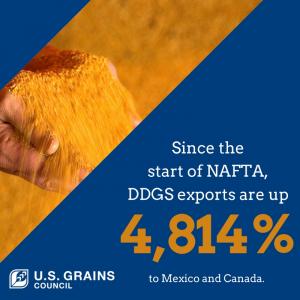The sixth round of negotiations on the modernization of the North American Free Trade Agreement (NAFTA) is happening this week, with U.S. Grains Council (USGC) staff leadership on the ground in Montreal to share the importance of NAFTA relationships to exports of U.S. coarse grains and co-products.
The sixth round of negotiations on the modernization of the North American Free Trade Agreement (NAFTA) is happening this week, with U.S. Grains Council (USGC) staff leadership on the ground in Montreal to share the importance of NAFTA relationships to exports of U.S. coarse grains and co-products.
In addition to offering expert information directly to negotiators on the current status of the NAFTA markets and the development of business relationships under the agreement, Gaibler and LeGrand are on hand to speak with press and others gathered to follow the process so pivotal to the future of the North American economy.Both Ryan LeGrand, UGSC director in Mexico, and Floyd Gaibler, USGC director of trade policy and biotechnology, are in attendance at the negotiations.
“The prevailing view is that this round is being portrayed as pivotal,” Gaibler said. “The hope is that we will begin to see flexibility on controversial provisions, with new ideas, counter proposals and other options coming to the surface and, hopefully, providing some positive direction on both the pace and substance of the negotiations.”
Gaibler will speak at a trilateral press conference on Friday, Jan. 26, with other agricultural industry groups demonstrating united support for modernizing and upgrading NAFTA. The event is sponsored by Farmers for Free Trade, a coalition working to educate about the importance of trade to agriculture, which brought a group of farmers to Montreal to help share how trade impacts producers down to the farm level. Gaibler is also participating in a roundtable discussion organized by Farmers for Free Trade on Friday, Jan. 26.
Since coming into effect in 1994, U.S. agricultural exports to Canada and Mexico tripled and quintupled, respectively. In fact, one in every 10 acres on U.S. farms is planted to feed hungry Canadians and Mexicans. Exports of feed grains in all forms to Canada and Mexico have increased by 300 percent over the last 24 marketing years (1993/1994 to 2016/2017), according to U.S. Department of Agriculture (USDA) trade data and analysis by the Council.
Mexico is now the largest export market for U.S. corn, thanks to the favorable terms for agricultural trade in NAFTA and the Council’s work to capitalize on this market access with decades of efforts to capture and build new demand. Since the agreement went into effect, Mexican imports of U.S. distiller’s dried grains with solubles (DDGS) have increased 945 percent, and Mexican imports of U.S. corn have grown 847 percent. Overall, Mexico purchased 547.2 million bushels of corn worth $2.5 billion last marketing year, setting a new record, in addition to 22.4 million bushels of sorghum and more DDGS and malting barley than any other country in the world.
Since NAFTA entered into force, exports of corn in all forms to Canada have increased nearly five times, including a 23 percent increase in corn exports, a 17-fold increase for DDGS and corn gluten feed/meal and more than a 172-fold increase for ethanol. In 2016/2017, Canada was the second largest customer of U.S. barley and ethanol, sixth largest for DDGS and eighth largest for corn gluten feed/meal.
On Tuesday, the Council joined a wide group of agriculture, business, industry and manufacturing groups in a social media outreach day – using the hashtag #NAFTAWorks – intended to share these market successes ahead of the next round of talks. This and other public outreach is a crucial complement to ongoing engagement in the formal talks, which are set to continue into spring.
Watch for an rundown of the full NAFTA round in next week’s Global Update. Until then, learn more about the Council’s work on NAFTA here.


